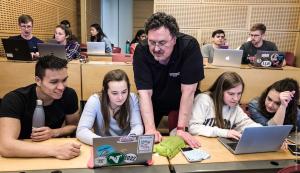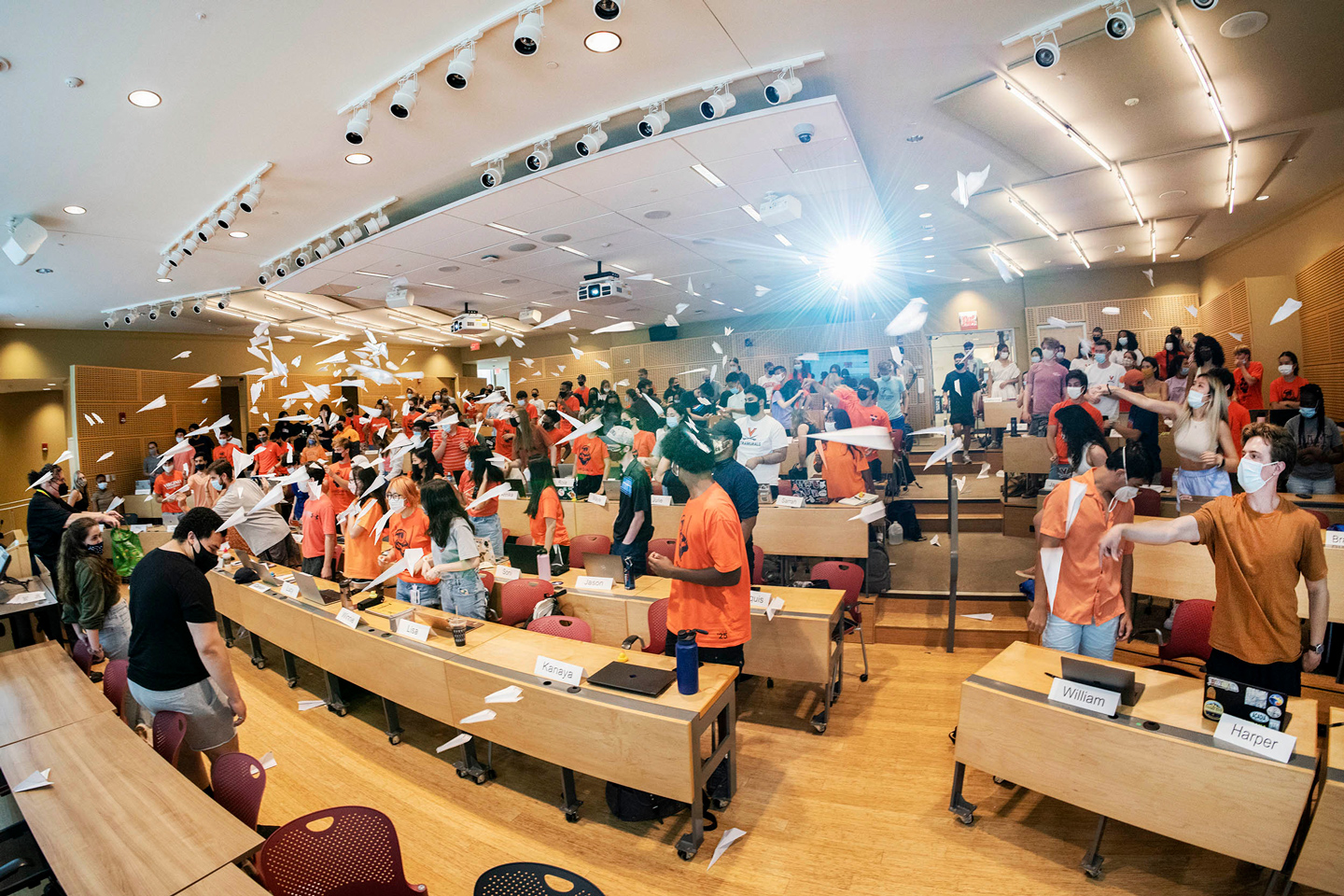
Here’s one thing to know about Jim Cohoon: He walked into most of his University of Virginia computer science courses wearing a shirt decorated with one of many haikus penned for his students.
When interviewed for this story, his shirt said: “Do not be afraid. / Do not hide what makes you, you. / You are welcome here.”
The shirts — all embroidered at a Charlottesville shop with verses that Cohoon supplies — are a fun fact to know about the professor who retired from UVA’s School of Engineering and Applied Science at the end of the 2023 academic year.
The poems also sent a message about computer science. Like haikus, Cohoon says, programming is “structured communication.” Most importantly, though, the haikus and the messages behind them were 17-syllable encapsulations of his life’s work — making computer science accessible to anyone who wanted to learn.
Broadening Participation in Computer Science at UVA
“The UVA thing I am most proud of is how the Department of Computer Science has become more representative of the population of our university itself, and how the department sought to become that way,” said Cohoon, who previously served as a co-associate chair for the department and director of its Bachelor of Science undergraduate program. The department also offers a Bachelor of Arts in computer science and co-offers a B.S. in computer engineering with the Department of Electrical and Computer Engineering.
Cohoon, who joined the faculty in 1983, recalls the percentage of women studying computer science at UVA falling behind the national average, although female students faced barriers everywhere. There were not a lot of opportunities to learn about the field early in their education. When girls did learn about computer science, many had trouble seeing themselves in the field or in the problems that computer scientists tackled.
Cohoon and a cohort of fellow leaders set about changing the status quo.
“We made a concerted effort, with a bunch of people, over many years. And still do so,” Cohoon said.
He helped design a new first-year curriculum for undergraduate students — the first introduction that students get to UVA’s computer science program, which is in the School of Engineering and Applied Science. The department created three different courses — one for students with no computer science experience, one for those with experience, and one general course.
“That has worked really well,” said Cohoon, who taught all three courses but is most closely associated with the one for students with no experience. That course is now often up to 65% women, he said, and many of those students go on to choose computer science as a major after enjoying the course.

“We have built up a really good pipeline for students to take the next course in the curriculum and to end up choosing the major,” he said. “For a while, more than half of those who chose computer science did not intend to major in computer science before exposure to our courses.”
One key, he said, is choosing well when picking problems to solve or research to share with students, and trying to connect with their interests in their daily lives.
“Often, faculty pick problems that interest them,” he said. “You have to pick things that motivate the students. Motivating students is the way to get them to learn. That is what I love to do.”
Cohoon typically started his courses with a survey asking students what problems they wanted to solve and used their interests to help structure the course. They might end up writing an app for weather forecasts, something students would use every day, or discussing image manipulation, something relevant to a generation of digital natives.
“I tried to motivate them and to also be empathetic. I wanted them to understand that computing did not come easy for me, but that I got to become who I am and do what I can do now,” Cohoon said. “I also wanted them to see that I am not just a white male, but a first-generation college student who had no idea college was even an option until my senior year of high school.”
Connecting Through Haiku — and Tapping What's Important to Students
The haikus are a way to show that empathy, even if he has not walked directly in their shoes. Some have referenced the Black Lives Matter or MeToo movements, emphasizing the importance of standing up for justice and equality.
Other haikus told students a bit more about Cohoon, including one referencing a linear algebra class he took in college: “How was I to know / Person sitting next to me / Would become my spouse.”
“I would joke that students should be careful who they sit next to. I loved after sharing that haiku, people would check out their neighbors,” Cohoon said, laughing.
Cohoon’s late wife, Joanne McGrath Cohoon, also was a member of UVA Engineering’s faculty in the Department of Engineering and Society. Joanne Cohoon was trained in sociology, with a Ph.D. from UVA.
She was a crucial partner in Cohoon’s efforts to diversify computer science at UVA and beyond. The couple worked together on National Science Foundation grants that funded the development of research-based strategies to help high school and community college computer science teachers improve diversity and retention rates in their courses.
The team members methodically tested strategies and resources to ensure their work was verifiable and reproducible, and developed a program for computer science teachers. Their resources were distributed throughout the country, teachers nationwide enrolled in their program, and a group came to UVA for in-person training every summer for many years.
“It was a tremendous success,” Cohoon said. “I am really proud of that work.”
Of course, Cohoon has also made other research contributions to the field, including in very large-scale integration — or VLSI — physical design, which focuses on optimal layouts for computer chips. For example, Cohoon attacked the tricky problem of how to connect two points on a chip as fast as possible, finding a technique to maximize efficiency and speed.
That is the kind of problem-solving Cohoon loves and what drew him to computer science in the first place.
“When I investigate problems, I try to think of new ways to solve things and create new tools, not just for the problem itself, but for new ways of finding solutions.”
He was constantly thinking about how to pass on this mindset to his students. One student, for example, loved Star Wars and Star Trek. Cohoon recalled working with him to frame computer science problems in ways that fit with what the student loved about those shows — allocation of resources, competition for the best solution, the constraints of various systems.
Taking the time to make those connections helped the student to thrive in Cohoon’s courses.
Unwavering Belief in Students' Potential
“He is a wonderful educator who cares deeply about his students,” Cohoon’s colleague Jack W. Davidson said in an interview prior to Cohoon’s retirement.
“He is really passionate about being inclusive, bringing students into computer science and giving them a really good first experience,” Davidson said. “He does so many interesting things in his class, makes his assignments really interesting and interactive and is just the nicest, kindest person. His students love him.”
Elizabeth Orrico, a 2015 UVA electrical engineering alumna who became Cohoon’s colleague as a computer science faculty member, was one of those students in Cohoon’s zero-experience introduction to programming course. He once gave out a photo of himself as a joke, but with a point, she recalled.
“It was like a framed picture of himself, but at the top he wrote, ‘You can do it,’” Orrico said.
The photo — his way of saying, “If I can do it, you can too” — was one of many caring touches he brought to the class, which Orrico said put her on a path to teaching computer science. And though it is not as effortless as Cohoon made it appear, she tries to emulate his approach in the classroom.
“I speak to my class with that undying belief in the potential of my students,” said Orrico, who earned a master’s in computer science after graduating from UVA. “I believe in them because I learned from him that if you believe in people, they’ll rise to the occasion. Take a room full of people who’ve never coded before and just say, ‘I know you can do it,’ and keep it light and keep it positive. And we all did it.
“I am just so grateful that Jim was my first exposure to this material and to this field that has brought me a lot of joy.”
That is the legacy that Cohoon will leave. The computer science department is now more diverse than during Cohoon’s early years in the department, ranking above the national average. And, generations of students have benefitted from his empathy, his love of teaching and his commitment to making every student feel they belong.
It’s a legacy Sandhya Dwarkadas, the Walter N. Munster Professor of computer science, appreciates — and related to why she came to UVA last summer to chair the department.
“I was impressed with its trajectory as well as the collegiality of the department, and was attracted by the opportunity to help shape its growth,” she said at the time.
“Jim was integral to that growth and in creating the ethos of UVA computer science. We intend to carry on his mission of diversifying the field and providing our students an education in computer science that is second to none.”
In retirement, Cohoon still looks forward to following computer science advances, such as how the world changes with artificial intelligence. He will also enjoy the fruits of another joint project he and his wife shared — bringing up a son and two daughters.
“Helping raise them to be great and caring people is my proudest accomplishment,” Cohoon said.
One also hopes he will continue to write haikus. For now, we will leave him with this one: A career well spent / Opening doors for others / Is haiku-worthy.